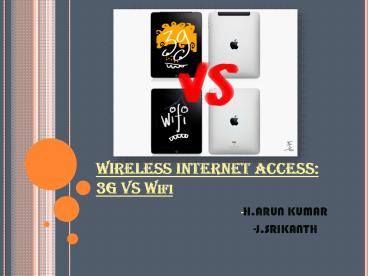WIRELESS INTERNET ACCESS: 3G VS Wifi PowerPoint PPT Presentation
Title: WIRELESS INTERNET ACCESS: 3G VS Wifi
1
WIRELESS INTERNET ACCESS 3G VS Wifi
-
-H.ARUN KUMAR -
-J.SRIKANTH
2
Introduction
- The two most important phenomena impacting
telecommunications over the past decade-the
internet and mobile telephone services. - The internet brought the benefits of data
communications to the masses with email, the web,
and ecommerce. - mobile service has enabled follow-me
anywhere/always on telephony. - To realize the full potential of this
convergence, however, we need broadband access
connections.
3
SOME BACKGROUND ON WiFi AND 3G
- 3G
- 3G is a technology for mobile service providers.
- To support the service, mobile operators maintain
a network of interconnected and overlapping
mobile base stations that hand-off customers as
those customers move among adjacent cells. - service providers will have to upgrade their
networks to one of the 3G technologies which can
support data rates of from 384Kbps up to 2Mbps
4
3G
5
WiFi
- WiFi is the popular name for the wireless
Ethernet 802.11b standard for WLANs. - Operate using unlicensed spectrum in the 2.4 GHz
band. - The current generation of WLANs supports upto
11Mbps, data rates within 300 feet of the base
station. - WLAN technology was not designed to support
high-speed hand off associated with users
moving between base station coverage areas.
6
WiFi
7
HOW ARE WiFi AND 3G SAME?
- BOTH ARE WIRELESS
- Avoids need to install cable drops to each device
when compared to wire line alternatives. - Facilities mobility.
- BOTH ARE ACCESS TECHNOLOGIES
- Both 3G and WiFi are access or edge/network
technologies. - Wireless service are part of an end-to-end value
chain that includes , in its coarsest delineation
atleast - The internet backbone ( the cloud )
- The second mile network providers (ILEC ,mobile ,
cable, or a NextGen carrier)
8
HOW ARE WiFi AND 3G SAME?
- BOTH OFFER BROADBAND DATA SERVICE
- Both 3G and WiFi support broadband data service,
although the data rate offered by WiFi (
11Mbps ) is substantially higher than the couple
of hundred Kbps expected from 3G services. - Both services will also support always on
connectivity which is another very important
aspect of broadband service .
9
HOW ARE THEY DIFFERENT?A.CURRENT BUSINESS MODELS
- 3G
- WiFi
WiFi
- 3G represents an extension of the mobile service
provider model. - The basic business model is the telecommunication
services model .
- WiFi comes out of the data communications
industry ( LANs) which is a bi-product of the
computer industry. - The basic business model is one of equipment
makers who sell boxes to customers.
10
HOW ARE THEY DIFFERENT?B.SPECTRUM POLICY AND
MANAGEMENT.
- WiFi
- 3G
- 3G and other mobile technologies use licensed
spectrum. - the licensee is protected from interference from
other service providers.
- WiFi uses unlicensed shared spectrum.
- Any member can access this service provided the
administrator has given permission to do so.
11
HOW ARE THEY DIFFERENT?C. STATUS OF TECHNOLOGY
DEVELOPMENT
- 3G(deployement status)
- WiFi(deployement status)
- 3G licenses have been awarded in a number of
markets at a cost of billions of dollars to the
licensees, it has only limited progress with
respect to service deployment
- We have a large installed base of WiFi networking
equipment that is growing rapidly.
12
HOW ARE THEY DIFFERENT?C. STATUS OF TECHNOLOGY
DEVELOPMENT
- 3G(Embedded Support for Services)
- WiFi(Embedded Support for Services)
- 3G was expressly designed as an upgrade
technology for wireless voice telephony networks. - 3G offers better support for secure / private
communications
- WiFi provides a lower layer data communication
service that can be used as the substrate on
which to layer services such as voice telephony. - WiFi offers security only to a local level unlike
3G.
13
HOW ARE THEY DIFFERENT?C. STATUS OF TECHNOLOGY
DEVELOPMENT
- 3G(STANDARDIZATION)
- WiFi(STANDARDIZATION)
- Formal standards picture for 3G is perhaps more
clear. - Relatively a small family of internationally
sanctioned standards, collectively referred to as
WCDMA.
- It may appear that the standards picture for
WLANs is less clear than for 3G. - WiFi is one of the families of continuously
evolving 802.11 x wireless Ethernet standards.
14
HOW ARE THEY DIFFERENT?C. STATUS OF TECHNOLOGY
DEVELOPMENT
- 3G(SERVICE/BUSINESS MODEL)
- WiFi(SERVICE/BUSINESS MODEL)
- 3G is more developed than WiFi as a business and
service model. - Represents an extension of the existing service
provider industry to new services, and as such,
does not represent a radical departure from
underlying industry structure.
- It is ofcourse in contrast to the 3G in terms of
business and service model. - WiFi is more developed with respect to the
upstream supplier markets, atleast with respect
to WLAN equipment.
15
3G Vs WiFi
16
Conclusion
- This article offers a qualitative comparision of
two wireless technologies that can be viewed
simultaneously as substitute and / or
complimentary paths for evolving to broad band
wireless access. - 3G-the preferred upgrade path for mobile
providers. - WiFi -one of the many WLAN technologies.
- Both technologies are likely to succeed in the
market place. - we expect 3G mobile providers to integrate WiFi
technology into their networks thus expecting
these two technologies to be complimentary in
their successful mass market deployment.
17
-
-------- -
---Arun Srikanth. -

